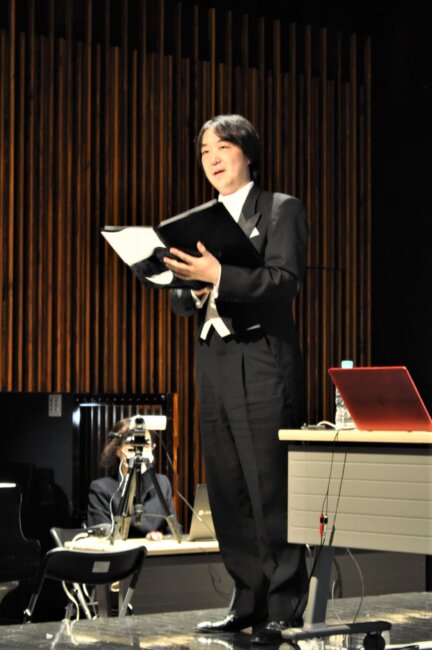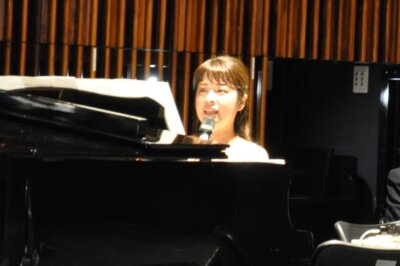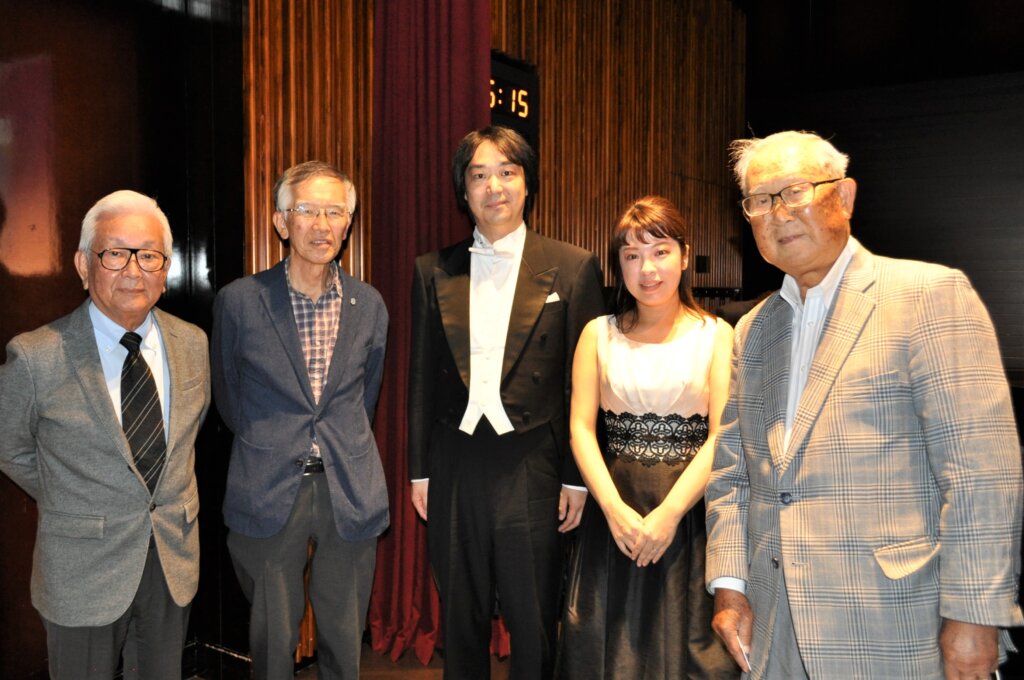Feel the Charm of Italian Opera
The Second 2022 Cross-cultural Awareness Workshop
Feel the Charm of Italian Opera
Date: October 29,2022 14:00~16:00
Venue: Minato City LIBRA Hall
At the beginning, there was an opening address by the former MUA President NAGANO and an introduction to UNESCO activities, followed by an introduction of the lecturers. After studying at Meiji University, Mr. WATANABE graduated from Tokyo University of the Arts and completed the opera course at the same graduate school. He aggressively conducts wide range of activities such as appearing in numerous operas, playing as a soloist in Beethoven’s Ninth Symphony or leading roles in operas at the New National Theatre
His wife, WATANABE Yuriko, is active as a pianist in various fields, and this time not only accompanied her husband, but also provided commentary during the lecture.
Lecturer WATANABE entered the stage singing “Kanpai no Uta” from Verdi’s “La Traviata” (1853). (Originally duet and part of the song was excerpted during the lecture.) When the lecturer asked at the beginning if anyone has ever seen the whole opera, quite a few people raised their hands.

“What is opera?”
Opera is a comprehensive art that combines drama and music. In big theaters, microphones are sometimes used, but unlike musicals, live voice is delivered to the audience. Depending on the pitch and weight of the voice, the role is also determined. The soprano and mezzo-soprano that are high voices often play the role of the main characters, while the deep alto voices play that of old women or maid. A tenor with a high male voice is a star player. However, as it is said that when the tenor fails, the opera as a whole is deemed to be a failure, I as a tenor singer feel a lot of pressure. The midrange baritone plays a variety of roles such as bad men or handsome men and very popular with women. A bass with a low voice plays the role of an important person or an elderly person. Light tenor voice is assigned to a young prince. Vocalization has changed as well. From the era when countertenors were the mainstream, it shifted to bel canto vocalization with the introduction of orchestra. As seen in the works of Verdi and Puccini voice became louder with the modern bel canto vocalization as the orchestra plays thicker role (as I call it). The people involved in opera are not only the singers, choruses, and orchestras, but also the directors (there exists staging that even exchanges the era), the stage design, lighting, costume design, stage manager, make-up artist, hair dresser, costumes, assistant conductors, etc. Music staffs belong to the theater in foreign countries, but there is only one theater for opera in Japan, the New National Theatre. Lyrics of opera are made of poetry and are verses. It creates rhythm. The stage setting of “Aida” is massive and, therefore, it can only be performed at a large theater. Quite expensive costumes are used in “La Traviata”. Audiences are drawn into an extraordinary world by such settings.
“Beginning of Opera”
Opera began in Florence in the sixteenth-century. It aimed to revive the Greek tragedy. In early days, a singer sang a single song. Monteverdi of Venice appeared and evolved the form of opera.
“Baroque Era”
Baroque means “distorted pearl”. The castrato, which castrated male singers produce high notes, played an active role. In the era of absolute monarchy, opera seria took up serious themes. The operas honoring the king were especially big deal and very costly. Recitativo which is sung like you speak and advances the story in front of the aria (solo) became to be utilized.
♬ “Ombra Mai Fu: Gentle Shade” from Handel’s “Serse” (1737-38)

“Mozart Age”
”Don Giovanni” was first performed in 1787. Around that time, the comedy called opera buffa became popular with the rise of citizens. With this, you don’t need a large cast like the story of the king, and it doesn’t cost money. Script writers appeared and Da Ponte’s trilogy (“The Marriage of Figaro” etc.) was produced. (Lecturer WATANABE Yuriko’s comment: Around 1500, when opera was born, there was no major key nor minor. Gregorian chant was made up of musical modes. When major and minor keys appeared, it becomes easier to create chords and accompaniment. Mozart composed 626 of his works in his short life and most is a major key. Although minor keys are sometimes used like in the overture of “Don Giovanni”, there are only 19 works that were in minor key. Those were concentrated around 1787 when his father Leopold died. Mozart inextricably linked the orchestra to the opera. As the music score was written as if it was intended for an instrument, it was very troublesome to sing.
♬ “Her Peace of Mind” from Mozart’s “Don Giovanni” Revised in 1788 Vienna Edition
“The Age of Bel Canto Opera”
In the first half of the 19th century, the bel canto vocal technique advanced in Paris. Rossini, Donizetti, Bellini, etc. played an active part. With the simple orchestral accompaniment, a finely rolling vocalization called Agilita came out. A technique called “Rossini Crescendo”, in which similar phrases are used to gradually increase and swell is characteristic.
♬ “Unknown Tears” from Donizetti’s ” L’elisir d’amore ” (1832)
“Long live Verdi”
In the latter half of the 19th century, the unification movement began in Italy, which was nothing more than a collection of disjointed city-states, and Verdi composed “Go, my thoughts, on golden wings” from “Nabucco” is said to be Italy’s second national anthem and every one of Italian people can sing this song. It expresses the passion for the homeland. Wagner is the same age as Verdi. His works are characterized by the magnificent orchestra that creates continuous, uninterrupted music.
When it comes to Verdi and Wagner’s operas, not only loud voices but also frequencies are used so as not to lose to the orchestra.

(Lecturer WATANABE Yuriko) Verdi evolved the orchestra into an opera that integrates the orchestra with the singing rather than the accompaniment.
♬ “Go, my thoughts, on golden wings” from Verdi’s “Nabucco” (1842)
“Melody Magician Puccini”
Puccini composed a number of hit operas, including “Tosca”, “Madame Butterfly” and “La Bohème”.
(Lecturer WATANABE Yuriko) The orchestra is devoted to the accompaniment. However, as Puccini has the orchestra in unison with the melody of the song, it’s hard for a singer. Puccini and Wagner used a technique called leitmotif. The leitmotif is to repeatedly play the same melody as used in the movie “Star Wars” when Darth Vader appears.
♬ “No one should sleep” from Puccini “Turandot” 1892
“Later Italian Opera”
After World War I, Italian opera began to die out. When movies became popular, the sale of opera was said to become one third of the movie. But Italian music lives on in movies and musicals. Nino Rota’s “Romeo and Juliet” is famous.
♬ Morricone “Love Theme” from the movie “New Cinema Paradise”
Questions and Answers after the Lecture
Q: How can I overcome language problems such as foreign languages?
A: In the first place, in opera, there is a drawback that it is difficult to hear high notes as words. That’s why subtitles are used. Even in Japanese opera, the opera “KAMIKAZE ~Kamikaze~” composed by SAEGUSA Shigeaki, in which I performed, has Japanese subtitles. It is possible to concentrate on the stage even while watching the subtitles and understand the content well. If you go through synopsis in advance, each scene and development will be easier to understand, and you can enjoy watching more.
Q: I’m 80 years old and learning opera. Is it okay to lower the pitch and sing if it doesn’t match my vocal range at a recital?
A: It is okay to transpose songs. However, if you do it in opera, the orchestral score has to transpose in its entirety as well. Also, if the range changes, the melody changes and the character may be altered. I think the teacher may well stick to the original tone. However, that is mainly for the cases of public performances, etc. As an individual, I think you can adjust the pitch, and thereby, you may enjoy singing opera.

(Written by YAMADA Yuko, the International Science & Culture Committee, and translated by SUDA Yasushi, the PR & Internet Committee Associate)
